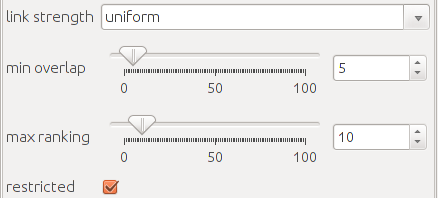Triadic cohesion clustering
Note: this page documents a visone functionality that will be in the next release.
More background information is presented at XXXIII Sunbelt Social Networks Conference of the International Network for Social Network Analysis (INSNA), Hamburg, Germany, May 21-26, 2013:
- Bobo Nick, Conrad Lee, Pádraig Cunningham, Ulrik Brandes: "Triadic Cohesion in Social Networks"
Please address questions and comments to Bobo Nick.
Where to find
Access is given via the analysis tab in the left-hand side of the visone window: set level to grouping, set class to clustering, and set measure to triadic cohesion clustering (TCC).
How to use
Ranking calculation
For each node, the algorithm will rank its outgoing neighbors according to an associated link strength attribute. For this purpose, undirected links will be initially split into reciprocal pairs of directed links.
- If uniform is selected (default), links are first weighted according to their Simmelian strength and afterwards ranked according to this newly created link attribute (termed triadType300).
- Otherwise, the rankings will be calculated according to the link strength attribute that was provided.
The resulting neighborhood rankings are saved in a link attribute termed rank.
Overlap calculation
Next, for designated pairs of nodes, the algorithm will calculate the overlap of top-ranked other nodes in their neighborhoods. Always, only the neighborhoods of connected pairs of actors will be compared. That is, each overlap comparison is associated with a directed link.
You can use the restricted parameter to further restrict for which pairs of actors the overlap is calculated:
- if selected (default), the overlap calculation is only performed for those links which have been top-ranked themselves
- if deselected, the overlap calculation is performed for each directed link
You can use the max ranking parameter to specify the maximal rank which is still regarded as a top-rank. That is, those outgoing neighbors that have been attached a rank greater than max ranking will not contribute in an overlap calculation. (Setting max ranking to zero will imply zero/undefined overlap values; only the ranking functionality is used.)
You can use the min overlap parameter to specify a minimal required overlap for a corresponding link not to be removed from the network when the overlap calculating are finished. (Setting min overlap to zero will imply that only links with undefined overlap value are removed from the network; set restricted to false to avoid this.)
The resulting overlap values are saved in a link attribute termed overlap.
Clustering calculation
The network transformation implied by the specified ranking and overlap filtering shall facilitate any subsequent clustering calculations. In the text field right of to attribute you can specify the name of the node attribute (default: triadic cohesion clustering (TCC)) in which preliminary cluster memberships are stored: visone's conductance cutting clustering algorithm with granularity parameter set to 0.2 is used to assign cluster memberships in the first place. Moreover, visone's quick layout functionality is used to visualize the modified network structure immediately.
Use apply to to select the network(s) for which the calculations shall be performed. Since the network structure is altered by the algorithm, you might want to show the result in a new network rather than this network. Having set all these options click on the analyze button at the bottom.


